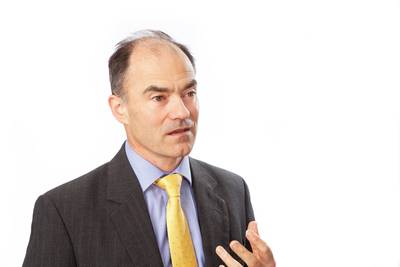The boss of Rolls-Royce wants to speed up change at the British engine maker, which is battling to recover from a string of profit warnings, saying more needed to be done to increase the group's resilience in the face of uncertain conditions.
The British company, which makes engines for fighter jets, commercial aircraft, ships and nuclear submarines, is one year into a programme to cut costs and simplify operations after a slowdown in several markets hit profits.
Chief Executive Warren East said cost savings would be towards the top of his target range, but he was not complacent.
"I'm restless," he told investors on Thursday. "I'm not happy with the rate of progress we are making."
Some analysts say the group has a mountain to climb, having made just 15 percent of a consensus full-year profit forecast of 686 million pounds ($854 million) in the first half of the year.
Broker Investec says the group faces both structural and strategic challenges: the wide-body market it supplies with engines is shrinking, the commercial aero engine aftermarket is changing to its detriment and a diversified industrial strategy continues to weigh on performance.
Rolls-Royce shares, which have recovered from a February low of 488.8 pence, closed down 2.1 percent at 738.5 pence.
One analyst, who declined to be named, said the company's cautious outlook, which included words like "challenging and mixed", had unnerved investors.
Rolls-Royce said demand for extra wide-body civil aircraft engines was strong, but there was further weakening in business aviation and no sign of recovery in offshore oil and gas markets and in marine, where the order book remained "very weak".
But East said he remained comfortable that profit and free cash flow expectations remained achievable.
Rolls-Royce said it now expected cost savings to be at the top end of a 150-200 million pound forecast range.
East has cut 20 percent of group management and accelerated the manufacturing process. For example, the firm is assembling a Trent 100 engine 27 percent quicker than a year ago, he said.
He said his team were starting to look beyond fixing the nuts and bolts towards longer-term strategy, where there were new technology opportunities, for example in electric engines.
"During 2017 there might be some output from starting to look more seriously at some of the strategic stuff, but I still expect a broad portfolio of different market applications," he told reporters.
New Standard
Rolls-Royce also highlighted a change in its accounting procedures to the IFRS-15 standard, designed to make the underlying performance of the business clearer.
"It doesn't affect the profitability of any contract, it is simply pushing back the timing of when we recognise that profit," finance chief David Smith said. "The new accounting standards do not affect our cash position in any way."
Under the rules, due to be brought in 2018, Rolls-Royce, which makes most of its money from maintenance rather than at the point of sale, will have to wait until it provides servicing before it can book more revenue and profit from long-term deals.
Broker Hargreaves Lansdown said when aftermarket revenues were booked upfront, much of the cash never materialised because some customers retired aircraft rather than having them serviced. "The new system should mean greater clarity," it said.
Rolls-Royce said its 2015 civil aviation operating profit would have been 900 million pounds lower under the new rules.
Rolls-Royce has not given a specific profit forecast for this year, other than saying it would take a 650 million pound hit due to weaker demand and other factors.
But Smith said cash flow from its civil aircraft business - its biggest - was improving.
"By implication we expect to see stronger cash flow for 2017, so something around or above break even next year for free cash flow is absolutely what we targeting," he said.
($1 = 0.8006 pounds)
(By Paul Sandle; Additional reporting by Tim Hepher; editing by Kate Holton, Mark Potter and Jane Merriman)

















